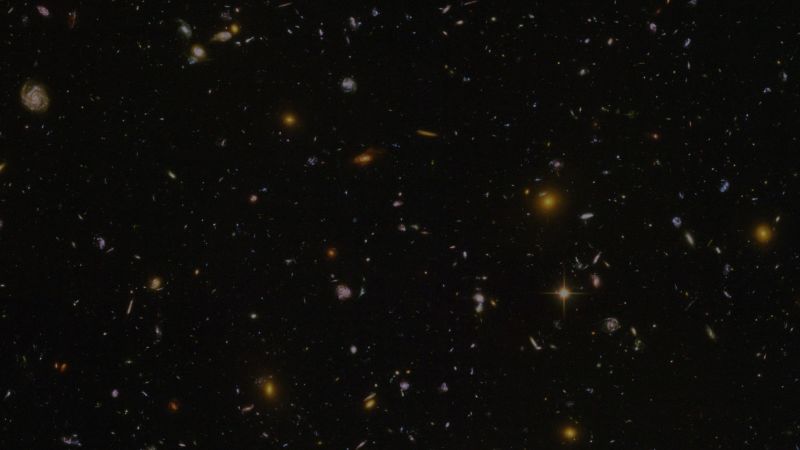Space is full of extreme phenomena, but the “Tasmanian devil” may be one of the weirdest and rarest cosmic events ever observed.
Months after astronomers witnessed the explosion of a distant star, they spotted something they have never seen before: energetic signs of life releasing from the stellar corpse about 1 billion light-years from Earth. The short, bright flares were just as powerful as the original event that caused the star’s death.
Astronomers dubbed the celestial object the “Tasmanian devil,” and they observed it exploding repeatedly following its initial detection in September 2022.
But the initial stellar explosion that caused the star’s death wasn’t any typical supernova, an increasingly bright star that explodes and ejects most of its mass before dying. Instead, it was a rare type of explosion called a luminous fast blue optical transient, or LFBOT.
LFBOTs shine brightly in blue light, reaching the peak of their brightness and fading within days, while supernovas can take weeks or months to dim. The first LFBOT was discovered in 2018, and astronomers have been trying to determine the cause of the rare cataclysmic events since.
But the Tasmanian devil is revealing more questions than answers with its unexpected behavior.
While LFBOTs are unusual events, the Tasmanian devil is even stranger, causing astronomers to question the processes behind the repetitive explosions.
“Amazingly, instead of fading steadily as one would expect, the source briefly brightened again — and again, and again,” said lead study author Anna Y.Q. Ho, assistant professor of astronomy in Cornell University’s College of Arts and Sciences, in a statement. “LFBOTs are already a kind of weird, exotic event, so this was even weirder.”
The findings about the latest Tasmanian devil LFBOT discovery, officially labeled AT2022tsd and observed with 15 telescopes around the globe, published Wednesday in the journal Nature.
“(LFBOTs) emit more energy than an entire galaxy of hundreds of billions of stars like the Sun. The mechanism behind this massive amount of energy is currently unknown,” said study coauthor Jeff Cooke, a professor at Australia’s Swinburne University of Technology and the ARC Centre of Excellence for Gravitational Wave Discovery, in a statement. “But in this case, after the initial burst and fade, the extreme explosions just kept happening, occurring very fast — over minutes, rather than weeks to months, as is the case for supernovae.”
Tracking the Tasmanian devil
Software written by Ho initially flagged the event. The software sifts through a half-million transients detected daily by the Zwicky Transient Facility in California, which surveys the night sky. Ho and her collaborators at different institutions continued to monitor the explosion as it faded and reviewed the observations a few months later. The images showed intense bright spikes of light that soon vanished.
“No one really knew what to say,” Ho said. “We had never seen anything like that before — something so fast, and the brightness as strong as the original explosion months later — in any supernova or FBOT (fast blue optical transient).
We’d never seen that, period, in astronomy.”
To better understand the quick luminosity changes occurring in the Tasmanian devil, Ho and her colleagues reached out to other researchers to compare observations from multiple telescopes.
Altogether, the 15 observatories, including the high-speed camera ULTRASPEC mounted on the 2.4-meter Thai National Telescope, tracked 14 irregular light pulses over 120 days, which is likely just a fraction of the total number of flares released by the LFBOT, Ho said.
Some of the flares only lasted tens of seconds, which to astronomers suggests that the underlying cause is a stellar remnant formed by the initial explosion — either a dense neutron star or a black hole.
“This settles years of debate about what powers this type of explosion, and reveals an unusually direct method of studying the activity of stellar corpses,” Ho said.
Either object is likely taking on large amounts of matter, which fuels the subsequent bursts.
“It pushes the limits of physics because of its extreme energy production, but also because of the short duration bursts,” Cooke said. “Light travels at a finite speed. As such, how fast a source can burst and fade away limits the size of a source, meaning that all this energy is being generated from a relatively small source.”
If it’s a black hole, the celestial object may be ejecting jets of material and launching them across space at near the speed of light.
Another possibility is that the initial explosion was triggered by an unconventional event, such as a star merging with a black hole, which could present “a completely different channel for cosmic cataclysms,” Ho said.
The afterlife of stars
Studying LFBOTs could reveal more about the afterlife of a star, rather than just its life cycle that ends with an explosion and a remnant.
“Because the corpse is not just sitting there, it’s active and doing things that we can detect,” Ho said. “We think these flares could be coming from one of these newly formed corpses, which gives us a way to study their properties when they’ve just been formed.”
Astronomers will keep surveying the sky for LFBOTs to see how common they are and uncover more of their secrets.
“This discovery teaches us more about the varied ways in which stars end their lives and the exotica that inhabit our Universe,” said study coauthor Vik Dhillon, professor in the department of physics and astronomy at the University of Sheffield in the United Kingdom, in a statement.







































